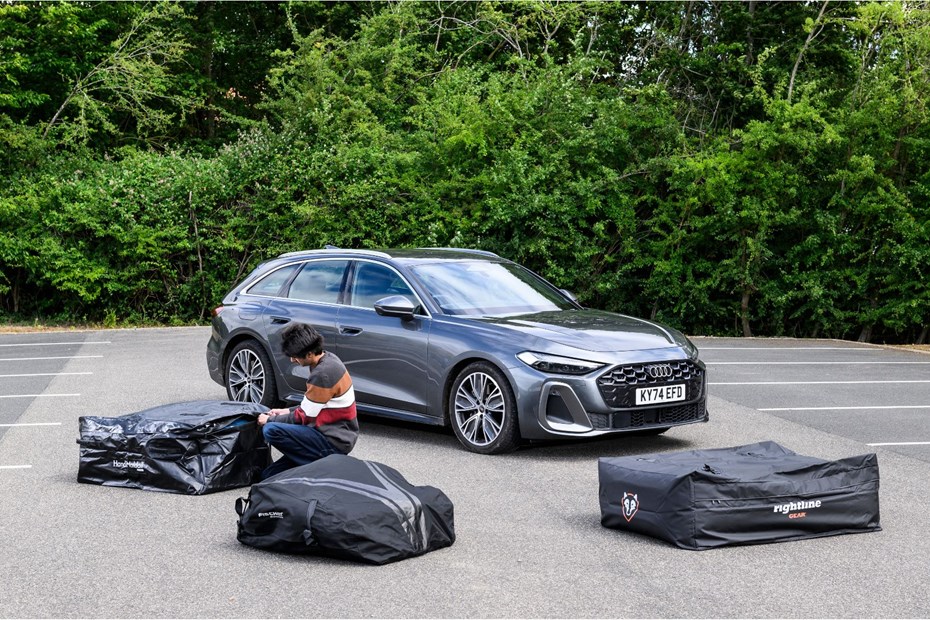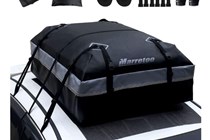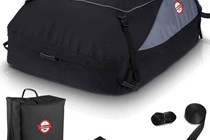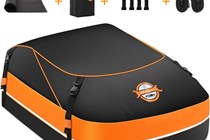Need extra cargo space for your next road trip? Car roof bags offer a cost-effective solution that can transform any vehicle into a long-distance hauler. Unlike expensive car roof boxes that can cost hundreds of pounds, roof bags provide flexible storage at a fraction of the price – but do they deliver the same protection and convenience? We’ve tested the best roof bags on the market to help you decide whether these fabric alternatives are worth choosing over traditional hard-shell boxes.
The aerodynamic limitations and wind noise of roof bags make them less suitable for extended motorway driving. We recommend them for shorter trips on quieter roads, while sleeker roof boxes are the better choice for long-haul or continental adventures.
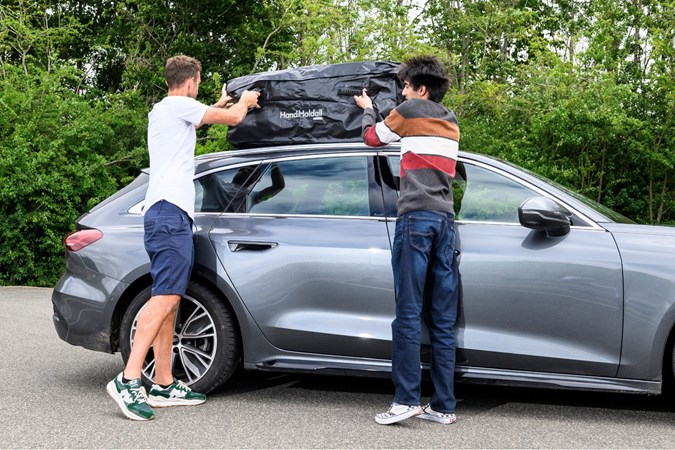
What is a car roof bag, and why use one?
A car roof bag is a soft, weather-resistant way to transport additional goods, which can be securely attached to your vehicle’s roof. It gives you that extra luggage space without the bulk of a hard roof box. Designed from flexible, durable materials like PVC or heavy-duty fabric, roof bags are just the ticket for carrying anything from camping gear to holiday luggage.
Unlike traditional roof boxes, roof bags don’t require as much storage space when not in use. They can be folded down and packed away in a cupboard or boot. They’re quick to install, lightweight, and a practical way to get more storage space for road trips or family holidays.
The best car roof bags 2025 at a glance
Benefits of car roof bags vs roof boxes
Both roof bags and roof boxes add storage, but it’s worth considering their differences:
- Cost-effective: Roof bags are generally cheaper than hard-shell roof boxes, making them ideal if you don’t want to spend too much money.
- Easy storage: When not in use, a roof bag folds down so that it doesn’t take up too much storage space. Roof boxes require much more garage space.
- Flexible fit: Roof bags can adapt to different load shapes and car sizes, whereas roof boxes have fixed dimensions.
- Lightweight and portable: They’re easier to lift and install compared to heavy roof boxes.
Who should consider using a roof bag?
A roof bag can be the perfect solution if you need occasional extra luggage capacity for holidays, camping trips, or family outings, but don’t have space to store a roof box at home. They offer an affordable alternative to roof boxes without too much of a compromise on capacity, and many work with cars that don’t have roof rails or bars by using door clips or straps instead. They’re also ideal for one-off trips or seasonal storage needs.
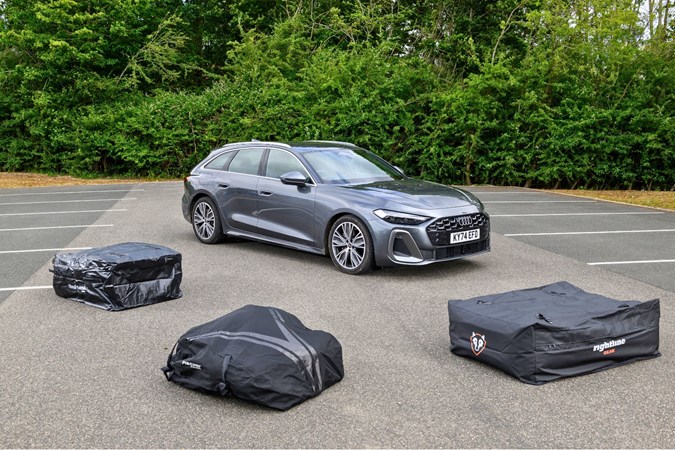
How to choose the best car roof bag for your needs
There are numerous roof bags on the market, so how do you know which one is best for you?
Key factors to consider
Capacity and dimensions: Think about the extra luggage space you might need. Roof bags typically range from 300L to over 600L. Larger bags are great for family trips, but make sure the size won’t overhang your roof.
Waterproofing and weather resistance: If you’re likely to face rain, snow, or dusty roads, waterproof material and sealed zips are essential. Some bags come with an additional protective cover for extra weatherproofing.
Compatibility with your car type: Check whether the bag fits your car. Some require roof rails or bars, while others can be secured using straps and door clips, making them suitable for cars without roof racks.
Installation method (with or without roof bars): If your car doesn’t have roof bars, you’ll need a bag that attaches directly to the roof using straps. If you already have bars or rails, get one that fastens securely to them for extra stability.
Security and lock features: Soft roof bags don’t offer the same security as hard boxes, but some models include lockable zippers or anti-theft straps. Worth considering if you’ll be leaving your car unattended.
Roof bag materials explained: what to look for
When choosing a roof bag, the material used in its manufacture is crucial for durability and weather protection. Here’s what to look for:
PVC or vinyl-coated polyester: These are among the most common materials for roof bags because they’re strong, waterproof, and resistant to UV rays. PVC-coated fabrics provide excellent protection against rain and snow, making them ideal for all-weather travel.
Heavy-duty nylon or polyester: Some roof bags use high-denier nylon or polyester for flexibility and tear resistance. Look for bags made from 1680D materials or higher for maximum durability. While these materials can be water-resistant, they often rely on an additional waterproof coating or rain cover to keep your belongings dry.
Welded seams and waterproof zippers: Even the best material won’t perform well if the seams and zips let water in. Look for welded or heat-sealed seams and zippers with storm flaps for maximum protection against leaks.
Reinforced base: A reinforced or padded base helps protect both the roof of your car and the bag’s contents, especially when carrying heavier loads.
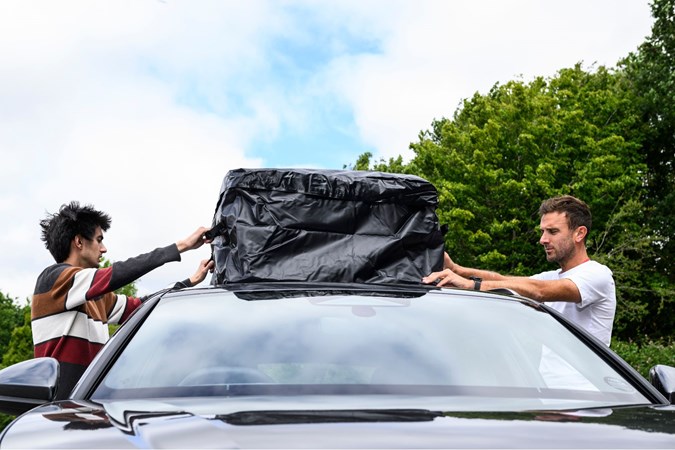
How we test roof bags
A roof bag is a good option to consider if, for example, you’re heading away into the Scottish Highlands or somewhere where you’ll be driving at lower speeds, where the roof bag’s aerodynamic flaws don’t matter quite so much. They’re also a very useful addition if you’re already carrying a bike rack or a converted campervan to give you extra storage space.
We grouped together a small batch of roof boxes and mounted them to a couple of different vehicles. These consisted of an Audi A5 Avant and a Dacia Duster press cars; the former we tried without the roof bars, and the Duster with a set of Thule WingBar Edge units.
We packed each roof bag with a series of equipment that you’d normally use to go camping. These consisted of sleeping bags, air mattresses, clothing, and more. We then mounted each one to the cars to test out the fixtures and fittings, including the straps, security and so on.
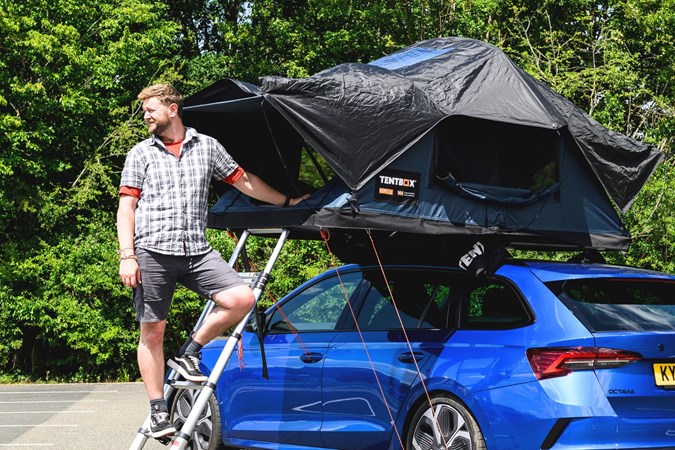
In terms of what we look for, practicality comes first. Roof bags are substitutes for more expensive roof boxes, so it’s nice to know if they can hold a decent level of equipment inside. Next up is durability: if the roof boxes feel sturdy in a material sense and feel secure on a vehicle, that’s hugely important to buyers. Because at the end of the day, nobody wants things breaking or flying off – especially at up to 70mph on the public highway.
Value for money is a nice bonus, but not completely essential. We say this because generally speaking, roof bags and indeed roof boxes are better in quality the more expensive they are. All of the above will be tied into our overall score of the product.
The best car roof bags 2025
The best car roof bag
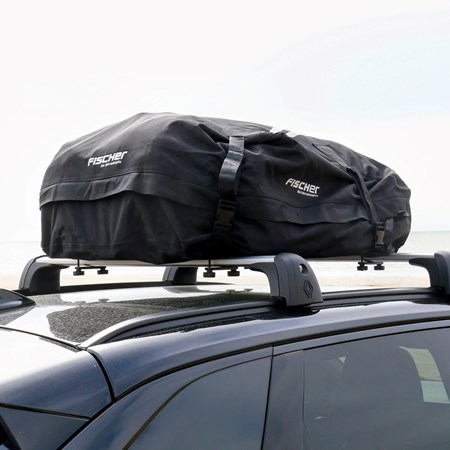

Some bags attach straight to the top of your car, but I've got a pair of roof rails and wanted something with a solid base that could attach to them. I've seen plenty of overpacked and under-structured bags sagging between a pair of rails on cars before, and that seems like a recipe for a scratched roof.
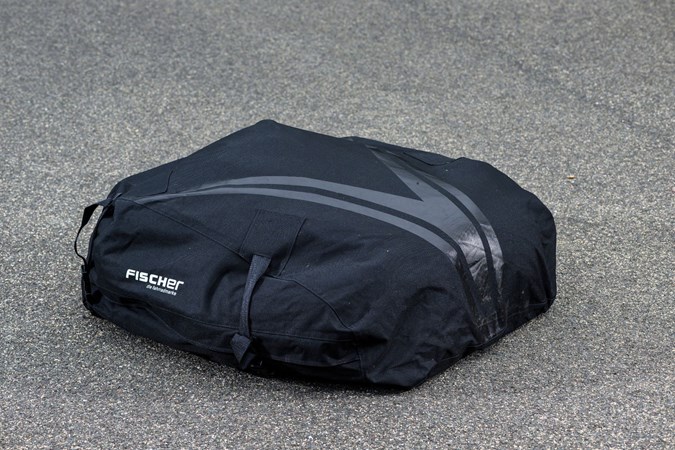
This Fischer roof bag is the perfect compromise if you want the rigidity of a roof box but the easy storage of a bag. It rolls up into the same sort of size and shape as a camping chair, and has three sturdy rails on the bottom to make installing and filling it a breeze.
Two of these rails have runners that capture the square head of a bolt, and then you clamp these around your roof bars with a plate and triangular thumb screws. It is a little fiddly but took me a maximum of ten minutes. I did have to move my roof rails closer together than I have them for my bike carriers, though.
Once installed, the bag opens fully thanks to a tough zip that runs three-quarters of the way around, and you can lash it down after packing it with four straps to stop things shifting around. I managed to get our gazebo, four camping chairs, two camp beds, plus a load of coats and a wetsuit in it, which was much more than I was expecting.
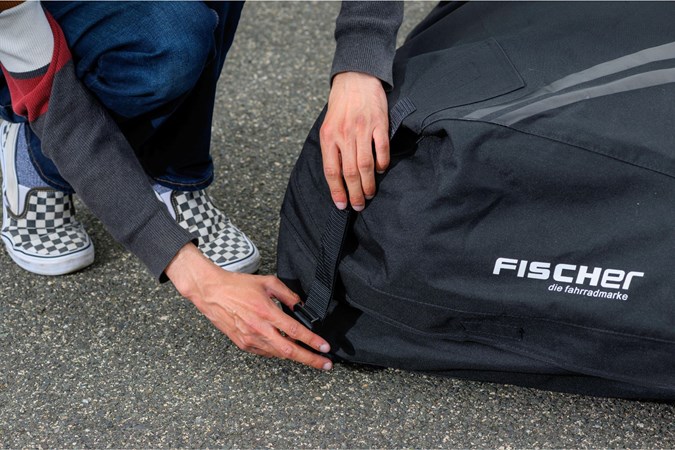
Bigger bags are available, but I like the compromise of the vaguely aerodynamic wedge shape that this one offers.
The description says it's only 'water resistant' but we drove in pouring rain and everything inside stayed dry. Just bear in mind there's a chance water (or thieves) could find their way in, so don't put anything particularly valuable or easily damaged up there, and you should be fine.
Review by Adam Binnie
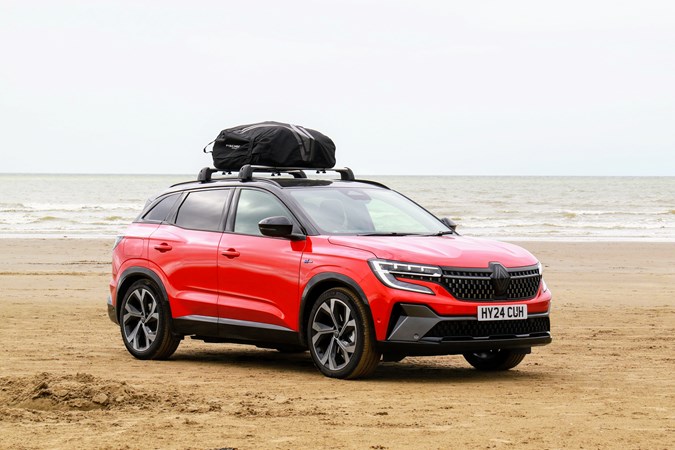
Pros
- Great build quality with thick materials and a neat design to compliment it
- Perfect blend of compactness and storage, making it useful for camping
- Compatible with all standard rail roof racks, including the Thule ones we put it on
Cons
- Not a massive volume at 270 litres, which is roughly half of some others
| Volume: | 270 litres |
| Dimensions: | 100cm (L) x 80cm (W) x 40cm (H) |
| Max load capacity: | 50kg |
| Weight: | 5.5kg |
| Needs roof rails? | Yes |
Editor's pick
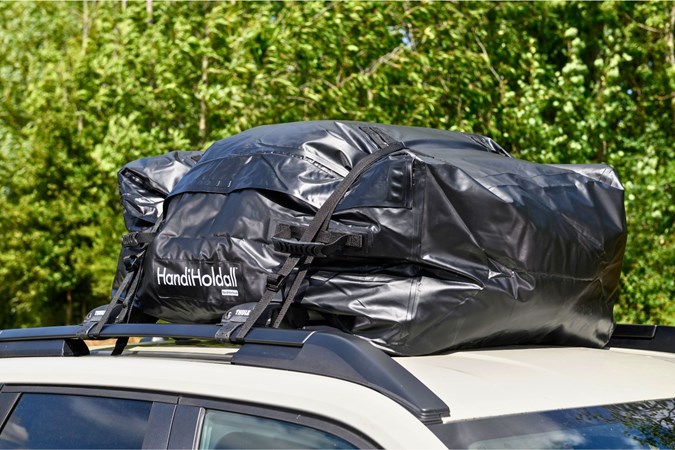

We mounted the bag on top of both a solid roof and on a set of Thule roof bars, and either way, it sat very comfortably on top of the vehicles.
The faux-leather materials of this bag mean that it has a slightly thicker feel than its competitors. It’s designed to sit on either the roof itself or on a set of roof bars – we recommend you mount it on bars to prevent any damage to the paintwork. I like the handles by the side which make it properly easy to lift – even if you have to enlist a helping hand.
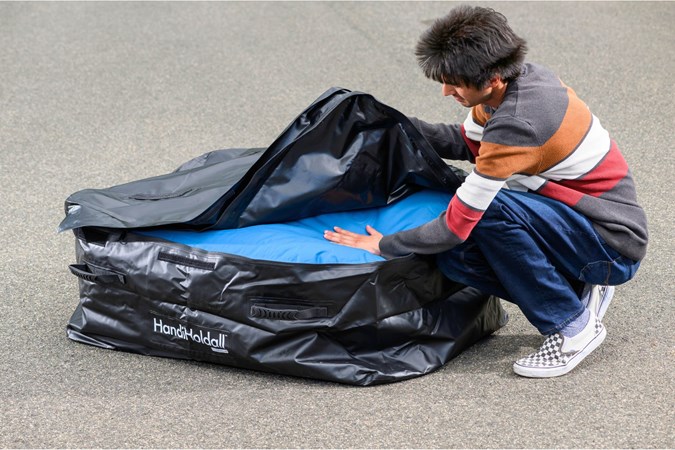
One thing to be really careful of is the metal straps that come with it. While they add a sense of security, you really don’t want these things to drag along the roof of the car and create scratches. They’re not even rubberised, so the sound of metal clanging on metal isn’t pleasing to anyone’s ear.
Overall, I really like the HandiHoldall. Of course, it’ll never win any style or aerodynamic competitions. But for the £150 mark, it’s a great value item to store a load of extra bits in for your camping holiday. It's a real bonus that it feels like a quality-item, too.
Review by Aaron Hussain
Second opinion, Nat Francis, Digital Operations Director
Initially, I was a bit apprehensive about using the HandiHoldall roof bag instead of a traditional roof box, mainly because I was concerned about a bag’s integrity and worried my belongings might end up scattered along the road. Fortunately, my concerns proved unfounded; the bag kept everything safe and secure even at motorway speeds.
I managed to pack a surprising amount inside, including an inflatable two-person kayak and paddles, a skim board, beach tent, buckets and spades, cricket set, boule set, a beach chair, wetsuit, and a few other odds and ends. Setting it up on the roof of my Renault Scenic was fairly straightforward – while I initially struggled with the straps, a quick review of the instructions made all the difference. However, I’d recommend double checking that all excess strapping is secured; we had to make an early stop when a stray strap started flapping against the roof.
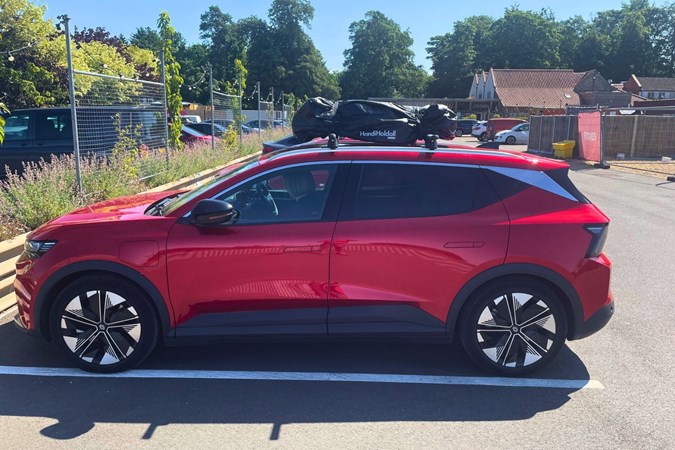
Driving with the bag, I found there was little noticeable cabin noise until I reached around 55 mph, at which point there was an audible (though not excessive) increase. The Renault Scenic calculated our 55-mile journey would use 15% of the battery, but in reality, it took 18% – so there is an impact on efficiency, though not dramatic, even with a well-packed but not quite full bag.
The car’s handling didn’t noticeably change, though I did drive a bit more cautiously, knowing the bag was mounted above. The biggest advantage came once we reached the coast: I could quickly remove, roll up, and stash the bag far more easily than any bulky hard shell box. Overall, I’d definitely use the Handi Holdall again – it’s practical, space-efficient, straightforward to assemble, and produces only minimal extra noise.
Pros
- Quite thick-feeling material gives the impresison that it's a quality bag designed to withstand many weather conditons
- Good value for money at around £150, which massively undercuts most roof boxes
- Rigid base makes it easier to install on a set of roof racks (we had no trouble mounting it onto a set of Thule bars)
Cons
- Not as aerodynamic as others with bulky design
| Volume: | 400 litres |
| Dimensions: | 110cm (L) x 75cm (W) x 40cm (H) |
| Max load capacity: | 50kg |
| Weight: | 3.6kg |
| Needs roof rails? | Yes |
Best car roof bag for capacity
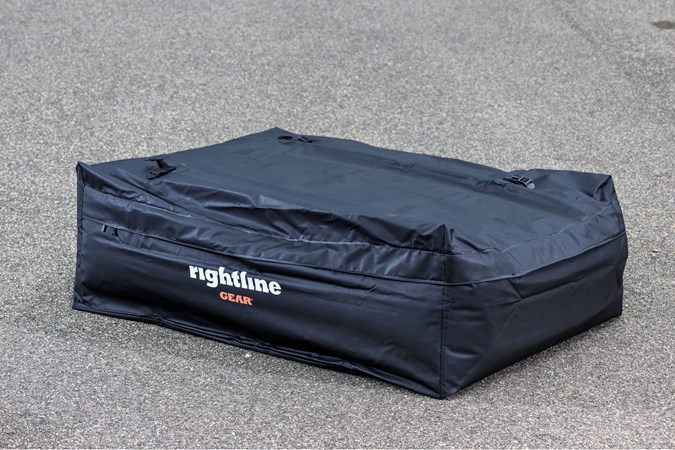

My first impressions of the Rightline Gear were positive; it’s obviously huge, so you can certainly fit most bits of camping gear in it. It’s also packed quite tightly, so storage isn’t an issue - and finding the zip isn’t a fiddly task, either.
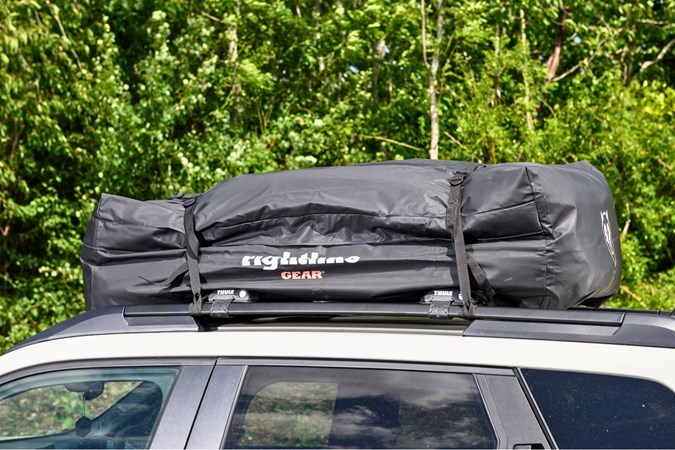
The feel of it isn’t bad, either. It’s a thick, substantial bag designed for all-weather conditions, so it’s bound to hold up well when it rains and snows. However, the positives end there, as we asked question after question when it came to installing it.
For one thing, the brackets included aren’t designed for any one vehicle. They’re supposed to mount on the side of the roof in-between the B and C pillars, but we decided against trying to use those as they never felt secure on our Dacia Duster test vehicle.
But when I tried to strap the bag in place using the Duster’s roof rails, the straps snapped – by the threads. I’m not the one to reveal too much about myself on the internet, but I only weigh eight stone and didn’t pull on the strap too harshly. So, that’s bad.
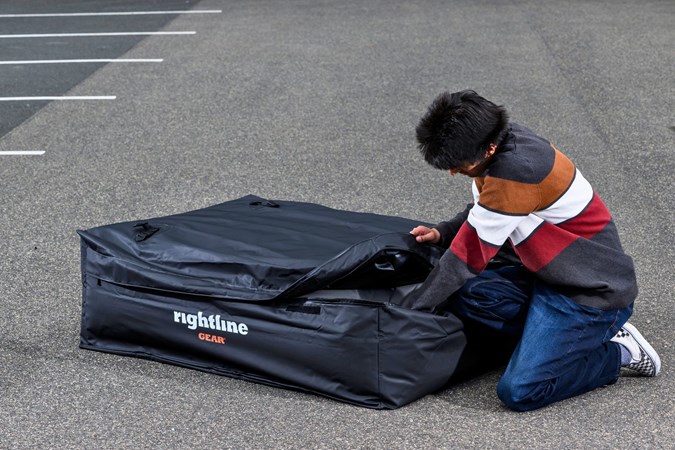
Even when the other straps were fastened in place, I seriously questioned the stability of it all. It felt quite loose and that the straps could come undone at any moment – and I feared any tighter fastening would result in another breakage.
Quite simply, the Rightline Gear 3 isn’t good enough. Not only do we feel it represents quality flaws, but scarily, critical safety concerns as well. If it was tied down well enough in the back of a pickup truck bed, perhaps there's a case for it. But as a roof-mounted bag? We think it's best if you look elsewhere.
Review by Aaron Hussain
Pros
- Huge amount of volume at 509L, meaning you can fit nearly everything inside for a camping holiday.
- Feels reassuringly weatherproof with thick materials and sturdy zips
Cons
- Straps were very weak on our test - these need improvement with a more secure fitting and durable materials
- We didn't find any use in the brackets provided
| Volume: | 509 litres |
| Dimensions: | 122cm (L) x 91cm (W) x 46cm (H) |
| Max load capacity: | Not given |
| Weight: | 3.7kg |
| Needs roof rails? | No |
Best waterproof car roof bag
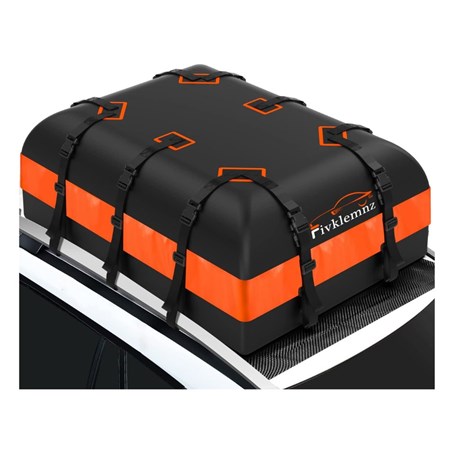

It comes with a combination lock and is designed to fit anything from regular-sized cars to SUVs and even vans. It's designed to be used with or without roof racks, depending on which you prefer. but it's designed to take in extra suitcases to be stored in a neat, waterproof compartment.
Pros
- Can hold multiple suitcases in one place
- Has 594 litres of space
- Designed to be water tight
Cons
- Not aerodynamic by any means
- Will add quite a lot of weight when filled up
Best aerodynamic roof bag
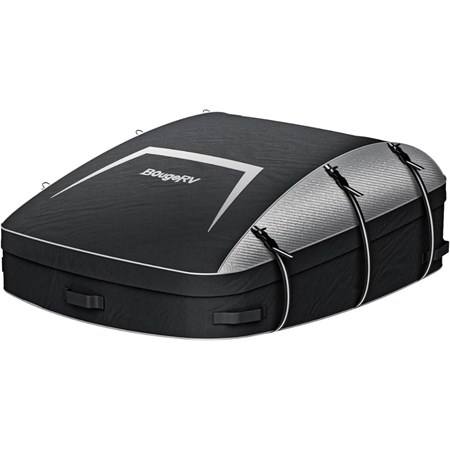

Some users have reported that it doesn't quite hold onto its waterproof label too well, which is worth bearing in mind if you intend to travel around usually wet areas, such as Scotland or Wales.
Pros
- Compact bag designed for a few extra items
- Sleek and aerodynamic which helps with fuel economy
- Can easily fit onto some roof racks
Cons
- Some users report lack of waterproof-ness
- Not everyone will want the smaller size
The best mid-range roof bag
Along with the bag, you also get an anti-slip mat, six door hooks, a storage bag, and a password-locking device. It's not designed to be attached to roof racks, which is a bit of a shame. But for value per litre, the Marretoo is a good shout.
Pros
- Huge storage at 594 litres
- Very durable and waterproof, thanks to heavy-duty fabric
- Comes with useful kit, such as locks and storage bag
Cons
- Isn't designed for a set of roof racks
- Not very aerodynamic
Best for smaller cars
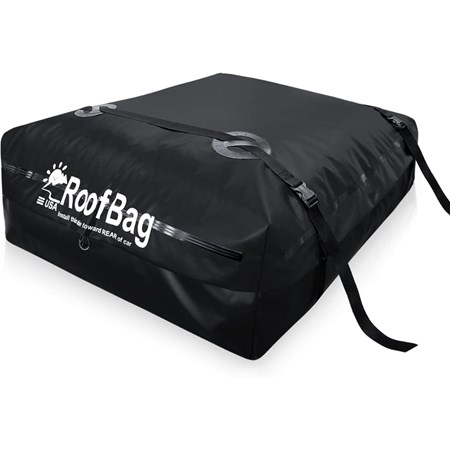

Like the Range 3, it too can be used with or without roof racks and sits directly on the roof in either case. Consequently, you may wish to pair it with a roof tray. Its construction is excellent and very durable.
Pros
- Size suitable for a range of smaller vehicles
- Highly durable and comes with anti-slip mat
- Can hold up to 368 litres, which is more than others
Cons
- Primarily designed for use without racks
| Volume: | 311 litres |
| Dimensions: | 102cm (L) x 94cm (W) x 43cm (H) |
| Max load capacity: | Not given |
| Weight: | 3.6kg |
| Needs roof rails? | No |
Best car roof bag on a budget
The 600D nylon fabric is waterproof and reasonably durable but you don't get that same level of build quality as seen on the other bags above.
Pros
- Good value for money at £70
- Large volume at 424 litres of space
- Suitable for a wide range of vehicles
Cons
- Build quality inferior to competitors
| Volume: | 425 litres |
| Dimensions: | 105cm (L) x 90cm (W) x 45cm (H) |
| Max load capacity: | Not given |
| Weight: | 2.7kg |
| Needs roof rails? | No |
Will a roof bag fit my car?
Before you buy a roof bag, it’s worth taking a few moments to consider whether it will fit your car. While most roof bags are designed to be versatile, doing a double check can save you some inconvenience.
Cars with roof rails vs without
If your car has roof rails or crossbars, you’ll have more options. Most roof bags can easily attach to these fixed points for a stable, secure fit. For cars without roof rails (sometimes called a bare roof), you’ll need a roof bag that uses strong straps running through the car doors. These designs work well, but make sure the straps don’t interfere with your door seals, as water could leak in during rainy weather.
Universal fit vs custom fit – what’s the difference?
Universal-fit roof bags are the most common and affordable option. They are designed to work on most vehicles and have adjustable straps for different roof shapes and sizes. Custom-fit roof bags, on the other hand, are tailored for specific makes or models, or indeed, even individual cars, ensuring an exact fit and often better aerodynamics. They tend to cost more, but if you frequently use a roof bag, the added security and quieter ride can be worth it.
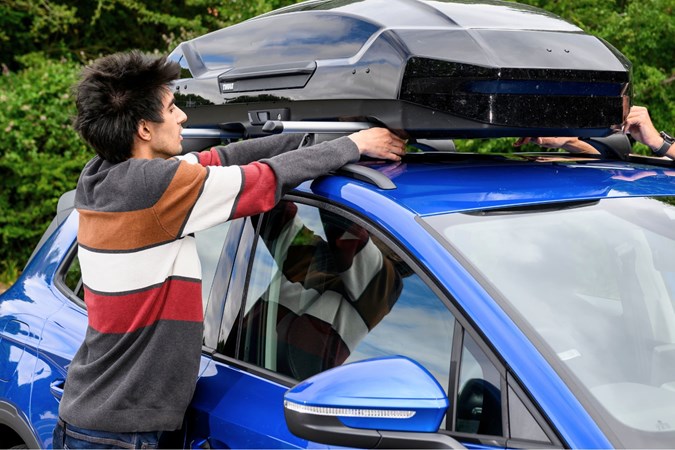
Are roof bags safe and secure?
If they are installed and fitted correctly, roof bags are safe for carrying your extra bits and pieces. However, their security may not be as good as that of roof boxes. It can depend on the quality of the bag, how it’s attached, and how you load it. If your bag doesn’t have lockable zippers and anti-theft straps, you can buy them as aftermarket products.
How to properly install a roof bag
The key steps to properly install a roof bag are:
1. Check that you have the correct type of bag and that it is compatible with your vehicle. Then make sure you have all the necessary straps and hardware, and additional tools and equipment you might need (a step stool could be handy, too)
2. Place the empty roof bag in the centre of the roof to ensure even weight distribution. If you have roof bars or rails, position the bag between them for extra stability.
3. With Roof Rails/Bars: Loop the straps around the rails or crossbars and tighten them evenly. Thread the bag’s straps under and around the crossbars or roof rails. Most bags use a crisscross pattern with 4-6 attachment points for stability.
Without Rails: Run the straps through the car doors as instructed by the manufacturer. Check that doors close securely and seals aren’t compromised.
4. Use the buckles to pull the straps tight so the bag doesn’t shift during travel. Tuck away loose strap ends to prevent flapping in the wind.
5. You’re almost ready to go. Remember to pack heavier items at the bottom and lighter items on top. Distribute weight evenly and avoid exceeding the bag’s weight limit.
6. Give the bag a firm shake before driving. After 15 or 20 minutes on the road, stop and recheck the straps for tension. The most common mistake is inadequate strap tension, which can cause the bag to shift or come loose while driving
Tips for driving with a fully loaded roof bag
Here are some essential driving tips when you have a loaded roof bag:
1. Do a pre-journey check each time: Ensure straps are tight and the bag hasn’t shifted. Stop and recheck after 15 to 30 minutes on the road and periodically on long trips.
2. Drive more slowly and smoothly: A roof bag adds weight and changes your car’s aerodynamics. Reduce your speed, especially on motorways, and avoid sharp turns or sudden braking.
3. Mind your height: Your car is taller with a loaded roof bag. Watch out for car park entrances, garages, toll barriers, and drive-thru lanes.
4. Avoid overloading: Stay within your car’s roof load limit (usually 50–75 kg, including the bag). Overloading can affect handling and damage the roof.
5. Watch the weather: Heavy rain can challenge even waterproof bags, and strong winds can increase drag. Drive with extra care in bad weather.
6. Distribute weight evenly: Put the heaviest items inside the car and lighter, softer items in the roof bag. This helps keep your car more stable.
7. Reduce wind noise: Tuck in any loose straps to prevent flapping. This will not only reduce noise but also avoid damage to paintwork.
Locking systems and anti-theft features
Unlike hard-shell roof boxes, most roof bags do not come with built-in locking systems. However, there are ways to improve security:
1. Lockable zippers: Some premium roof bags feature heavy-duty zippers that can be secured with small padlocks. This won’t make them theft-proof, but it does act as a deterrent.
2. Strap locks and cable locks: For added security, use a steel cable lock or strap lock to attach the roof bag to your car’s roof bars or rails. This makes it harder for someone to remove the entire bag quickly.
3. Hidden straps and zippers: Certain models include flap covers over zippers and straps, making it less obvious how to access or remove the bag.
4. Park sensibly: Even with locks, soft roof bags aren’t 100% secure. If possible, park in well-lit or monitored areas, and avoid leaving valuables in the bag overnight.
Caring for your roof bag
Proper care will extend the life of your roof bag and keep it performing well trip after trip. Neglecting maintenance can lead to leaks, tears, and a shorter lifespan.
Cleaning and storage tips
1. Clean after each trip: Wipe down the exterior with a damp cloth and mild soap to remove dirt, road salt, and debris. Avoid harsh chemicals as they can damage waterproof coatings.
2. Dry completely: To prevent mould and mildew, make sure the bag is fully dry before storage. If possible, leave it open in a ventilated area.
3. Fold carefully: Follow the manufacturer’s folding guidelines to avoid creases that can weaken the material.
4. Store in a cool, dry place. When not in use, keep it out of direct sunlight, as UV exposure can degrade the fabric over time. If provided, use the storage bag or case.
Common mistakes to avoid
1. Storing while damp: Packing the bag away while it is still wet is the fastest way to cause mould and those ‘wet dog’ smells.
2. Overfilling: Putting in too much stuff can strain zippers and seams, which in turn will reduce waterproofing.
3. Leaving it on the car roof long-term: Prolonged exposure to sun, wind, and rain can cause unnecessary wear. Remove the bag from the car when not in use.
4. Using abrasive cleaners: Harsh chemicals can damage the fabric and waterproof layer. Stick to a mild soap and water.
FAQs About Car Roof Bags
-
Do roof bags damage paintwork?
Generally, no, when used properly. However, damage can occur if dirt gets trapped between the bag and the roof, or if the bag shifts and rubs against painted surfaces. To prevent this, clean your roof before fitting and make sure the bag is properly secured. Try to avoid dragging the bag across the roof when loading or unloading.
-
Can you use them in the rain?
Yes, but it's worth having a safeguard or two in place. Most roof bags are water-resistant rather than completely waterproof. They'll handle light rain and road spray, but heavy downpours or prolonged exposure can let water in. For maximum protection, pack items in waterproof bags or plastic liners inside the roof bag.
-
Do they make noise while driving?
You'll probably notice increased wind noise. Well-secured bags produce mainly a low whooshing sound. However, loose straps can flap and create loud slapping noises, and poorly packed bags may produce rattling sounds from shifting contents. If noise suddenly increases while driving, stop and check that everything is still secure. The increase in noise is usually most noticeable at higher speeds.
-
What’s the best way to pack them?
Pack heavier items at the bottom of the bag, or even better, in the car if you can. Lighter, softer items can go on top. Distribute weight evenly inside the bag and avoid overfilling, as this can stress zippers and seams. Use compression straps inside the bag if available to keep items from shifting during the journey. Avoid sharp edges and wrap or pad anything that could puncture the bag from inside.
Sign up to the Parkers Newsletter to keep up to date with more of the latest reviews, news and recommendations from the Parkers team.
Just so you know, we may receive a commission or other compensation from the links on this website - read why you should trust us.


